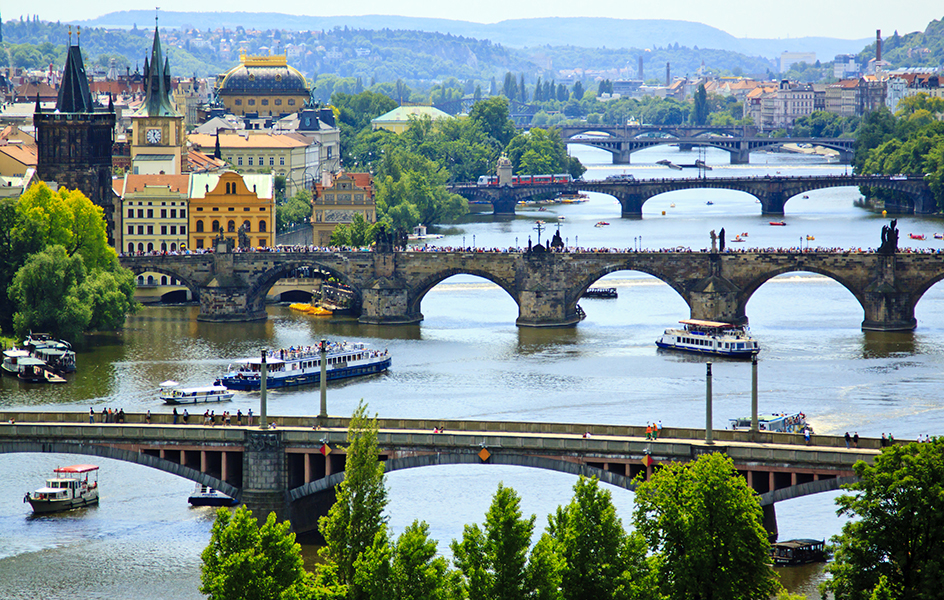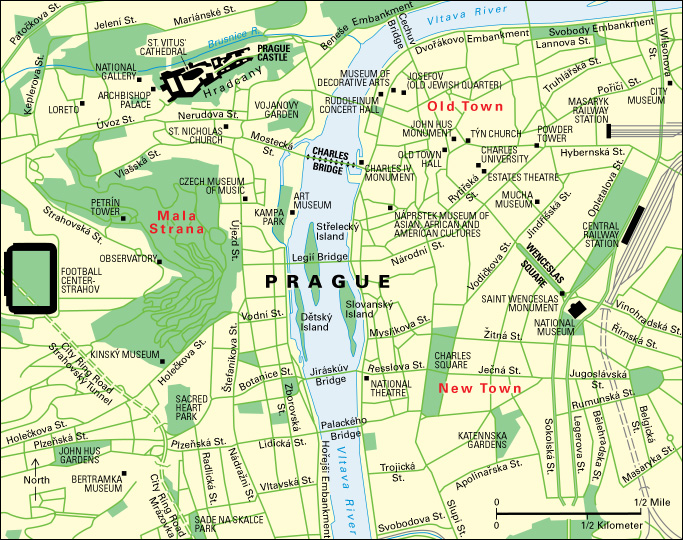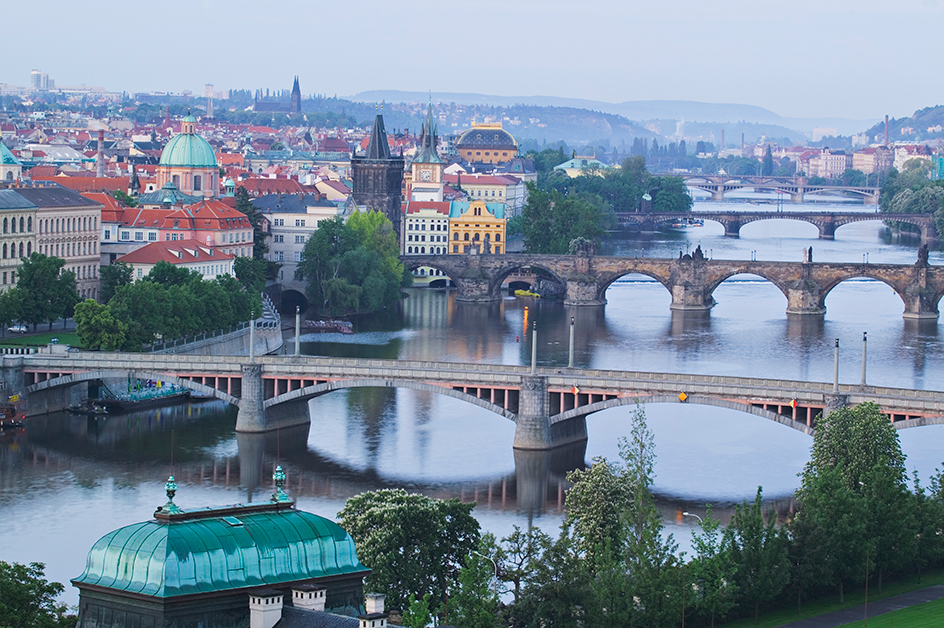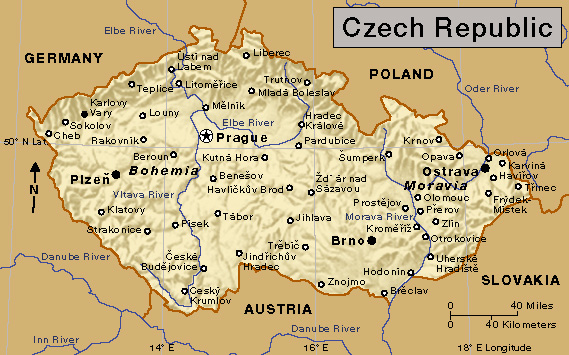Prague, << prahg >> (pop. 1,301,432), is the capital and largest city of the Czech Republic and an important center of culture and learning. Prague, called Praha in the Czech language, is one of the oldest and most beautiful cities in central Europe. It lies on the Vltava River, in the central part of the country. Prague is called the “City of a Hundred Spires” because of its many churches. It was one of the few central European cities that escaped major damage during World War II (1939-1945).

The city
lies on both banks of the Vltava River. A number of bridges connect the two sections of Prague. The Charles Bridge, a stone structure lined with statues of saints, is the most famous one. The city covers about 70 square miles (180 square kilometers). Much of the city’s area is made up of scenic hills.

Vltava River in Prague
Prague Castle, once the home of the kings of Bohemia, stands on Hradcany (Castle Hill) on the left bank of the Vltava River. Prague Castle houses a number of art treasures, and part of the castle serves as the official residence of the president of the Czech Republic. St. Vitus’ Cathedral also stands on Hradcany. Many beautiful old palaces and other structures line the narrow, winding streets of Mala Strana, a district of Prague that is located on the slopes and at the bottom of the hill.
Loading the player...Hradcany Square in Prague
Old Town, the historic center of Prague, lies on the right bank of the Vltava, across from Hradcany. Old Town Hall and the Tyn Church are in Old Town Square. Old Town Hall, built during the 1300’s, served as the seat of the city government for hundreds of years. It has a famous clock with statues of the 12 apostles that move every hour. A monument to John Hus, a religious reformer of the early 1400’s, stands in the middle of the square. The Tyn Church was the main church of the Hussite reformers (see Hus, John). Many buildings of Charles University, founded in 1348 by King Charles IV of Bohemia, are in Old Town.
The business center of Prague is in New Town, also located on the right bank of the river. Much of the New Town area was built during the 1800’s. Its Wenceslas Square–which is actually a wide boulevard lined with hotels, restaurants, and shops–is the busiest street in Prague. The National Museum occupies one end of Wenceslas Square. A statue of Saint Wenceslas stands in front of the museum. Prague also has many other museums, as well as libraries, theaters, opera houses, and concert halls.
Residential neighborhoods lie north, south, and west of Prague. Factories have been built chiefly in the eastern and southern suburbs.
People.
Most of Prague’s people are Czechs. The city had a large German community before World War II, but most of the Germans were expelled after the war. Because of government restrictions on migration to Prague and a low birth rate, the size of the population has increased only slightly since the war ended.

Prague has a housing shortage. Many houses in the city were built during the early 1900’s and are in poor condition. Since the mid-1900’s, the government has constructed many apartment buildings in the suburbs. But many people still live in crowded city apartments.
Economy.
Prague ranks as one of the country’s leading manufacturing centers. The city’s most important industrial products include aircraft engines, automobiles, beer, chemicals, diesel engines, furniture, machine tools, optical instruments, processed food, and streetcars. Prague also is an important railroad center. 
History.
Prague was probably founded during the A.D. 800’s. It soon grew into an important trading center. In time, the city became the residence of the Bohemian kings, who were crowned in St. Vitus’ Cathedral. King Charles IV, who also ruled the Holy Roman Empire, erected many important buildings. He founded the first university in central Europe in Prague in 1348. The Hussite religious reformation began in Prague during the 1400’s, and Prague suffered much damage in the religious wars that followed.
Loading the player...Prague Castle
The Thirty Years’ War began in Prague in 1618 after Protestant Bohemians rebelled against the Roman Catholic Habsburg (or Hapsburg) emperor. The revolt failed, and the Habsburgs ruled Prague until the end of World War I in 1918. That year, the city became the capital of the new nation of Czechoslovakia.
Loading the player...St. Vitus Cathedral, Prague
German troops occupied Prague during World War II. Many of Czechoslovakia’s people, including thousands of Jews, were killed by the Germans. In 1945, at the end of the war, the Soviet Army entered Prague. The Czechoslovak Communist Party, supported by the Soviets, took control of Czechoslovakia in 1948.
For a brief period in 1968, Prague was the center of a liberal reform movement, sometimes called the Prague Spring, in Czechoslovakia. The movement ended after tanks and soldiers from the Soviet Union and several other Eastern European Communist countries swept into Prague. In the late 1980’s, Prague was also the center of the movement that led to the end of Communist control of Czechoslovakia. In 1993, the independent countries of the Czech Republic and Slovakia were formed to replace Czechoslovakia. Prague remained the capital of the Czech Republic.
